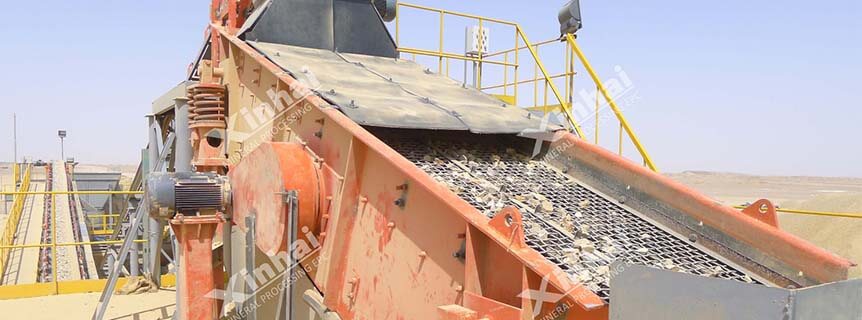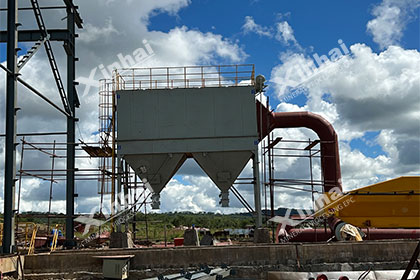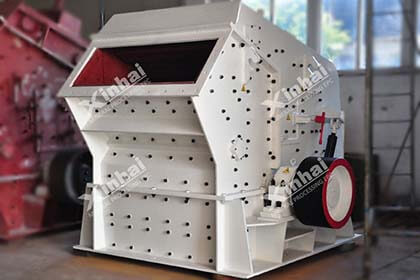4 Important Parts to Know More about Screening Equipment
 Laura
Laura
 Dec 27, 2022
Dec 27, 2022
 1308
1308
If you want to know more details about equipment, solutions, etc, please click the button below for free consultation, or leave your requirements!

(Screening equipment in mineral industry)
01Brief Introduction of Screening Equipment
BackIn the industrial sector, there are many types of screening equipment, such as fixed sieve, tumbler sieve, tube sieve, shaking sieve and vibrating sieve, etc., of which vibrating sieve (including ordinary vibrating sieve, resonant sieve, probability sieve and equal thickness sieve) is most commonly used.
Vibrating screen is a machine that uses the vibrating porous working surface to classify the mixture material with different particle sizes according to particle size, and this classification operation is called screening. Screening work is generally M used for the classification of materials of size 1 to 300 mm or finer (up to 0.05 mm, or even smaller). When the vibrating screen is used for grading, one layer of screen surface can obtain two kinds of products; with n layers of screen surface grading, n + 1 kinds of products can be obtained.
In addition to classification, vibrating screen is often used for material dewatering, i.e., to remove the water in the material; desmear, i.e., to clean and recover the heavy media particles in the screening equipment (in the heavy media coal selection work, the selected coal and gangue are often adhered to the shield media, usually cleaned with water and recovered); vibrating screen is also often used to clean the sludge on the surface of the material.
According to the different screening tasks, screening operations can be divided into the following categories
(1) Independent Screening
Screening after screening the product into the finished product screening is called independent screening. For example, in the coal plant, the raw coal into several different particle size level products and directly for consumer use, is the use of independent screening to complete the method.
(2) Pre-screening
Screening operations for the next step of processing is called preparatory screening.
In the beneficiation plant, such as the use of gravity separation, electromagnetic separation and other beneficiation methods, the requirements of the ore in a certain range of particle size.
Therefore, before sorting, the ore must be divided into a number of levels, in order to facilitate effective sorting operations.
(3) Auxiliary Screening
Auxiliary screening operations are combined with the crushing operation.
Its purpose is when the ore into the crusher before, it will meet the requirements and do not need to crush the qualified products screened out; or crushed by the crusher to check the product, screen out too large unqualified products sent back to the crusher to continue to crush. The former is called pre-screening, while the latter is called inspection screening.
If a screening machine performs both pre-screening and inspection screening tasks, it is called pre-inspection screening.
(4) Other screening
For example, dewatering, demineralization and desliming, etc.
02Screening Methods
BackAt present, the screening methods that have been applied in the industry are ordinary screening method, thin layer screening method, probability screening method, equal thickness screening method, etc.. Here we will talk about the characteristics of these screening methods.
1 Ordinary Screening Method
In the industrial sector, the long-standing screening method is the ordinary screening method, which is a medium material layer thickness screening method, screening in the ordinary vibrating screen and resonance screen is the use of this screening method. It has the following characteristics.
(1) The thickness of the material layer is generally 3 to 6 times the size of the screen hole.
(2) The number of sieve layers is 1 to 2 layers.
(3) The permeability of the material Pellet is in accordance with the size of the sieve hole under the continuous vibration of the sieve surface. Material particles smaller than the sieve hole in the process of movement along the sieve length direction, constantly through the sieve hole; and greater than the sieve hole material particles along the direction of the sieve surface, and finally discharged from the top of the screen.
Using the ordinary screening method to sieve the material, the material permeability process is carried out more slowly. In the case of a certain sieve length, the screening efficiency of this screening method is low.
In addition, the general screening method is generally only applicable to granular or lumpy material screening.
2 Thin Layer Screening Method
Thin layer screening method is a screening method under the condition of extremely thin material layer. This method is usually applied to the screen surface directly excited screening equipment, such as screen directly excited electromagnetic vibrating screen, cam type vibrating screen, double-excited motor type linear vibrating screen, etc.. Mainly has the following characteristics.
(1) the ratio of material layer thickness h and screen hole size a is usually 1:1~2:1, i.e. h/a=1~2.
(2) The sieve surface is usually single or double layer.
(3) the material movement speed is more business, suitable for often 0.5 ~ 1 m / s.
(4) feed width and screening equipment width ratio is close to 1:1.
(5) the applicable separation size is generally 0.05 ~ 5 mm, the most common 0.1 ~ 3 mm.
(6) is appropriate to use high frequency, small amplitude, vibration frequency - generally 1500 ~ 6000 times / min, the corresponding amplitude of 3 ~ 0.125 mm.
(7) The applicable screen inclination angle is generally 25°~45°.
Thin layer screening method is suitable for fine grain material or ultra-fine grain material screening.
When using the thin-layer screening method, screening equipment in front of the need to add the attached fabric equipment to ensure that the feed material is evenly hooked.
3 Probability Screening Method
Probability screening method effectively in accordance with the probability theory to complete the entire process of material screening. It mainly has some characteristics as follows.
(1) the use of multi-layer screen surface, generally 3 to 6 layers.
(2) the screen surface to use a large installation angle, generally 25 ° ~ 60 °
(3) the use of larger screen holes, screen hole size and separation size (the maximum size through the screen hole) ratio equal to 2 ~ 10.
Probability screening method dynamic use of the probability principle, making the screening process in this screening equipment is very fast, the material in this screening equipment in the time generally 3 to 6 seconds, while in the ordinary screening equipment takes about 10 to 30 seconds. Therefore, it can be said that the screening carried out on the probability sieve belongs to the fast screening.
The advantage of the probability screening method is that, due to the use of large screen holes, large inclination and multi-layer screen surface, the material into the sieve can be quickly through the screen, but also to overcome the shortcomings of the ordinary screening method is easy to pledge the sieve hole, eliminate the impact of critical particles, reduce the wear and tear of the screen surface, improve the processing capacity of the unit area.
4 Equal-Thickness Screening Method
Equal-thickness screening method is also called large thickness screening method. This method is characterized by, regardless of the percentage of particles smaller than the sieve hole in the incoming material, the thickness of the material layer on the screen in the screening process remains unchanged or increasing; while using the ordinary screening method, the thickness of the material on the screen is decreasing.
Equal-thickness screening method in the acceleration of the feeding end is larger than the ordinary screening method, thus increasing the acceleration of the material layer, the material layer quickly thinned, and quickly stratified. For the stratified material, and then apply the same acceleration as the just pass screening method, and the material through the screen.
The equal-thickness screening method makes the probability of contact between small particles and the sieve surface increase significantly, and the average unit area permeability is about 80 % of the actual permeability of the sieve surface. Therefore, the equal-thickness screen can increase the processing capacity of the screening equipment exponentially.
03Types of Screening Equipment
BackThere are many types of screening equipment, which can be divided into ordinary vibrating screen and resonance screen, thin material layer vibrating screen, probability screen, natural layered equal thickness screen and probability - equal thickness screen, etc. according to the screening method.
Screening equipment can be divided into the following categories according to their structural characteristics.
1 Inertia Vibrating Screen
The use of inertia exciter excitation, this screening equipment usually works in a far more resonant state, divided into single-shaft circular motion vibrating screen and two-shaft linear vibrating screen.
(1) Single-Axis Circular Motion Vibrating Screen
Excited by the single-shaft inertia exciter, the body of the trajectory of the circle or nearly elliptical circumference
(2) Double-Axis Inertia Vibrating Screen
Excited by the two-axis inertia exciter, the body of the trajectory for the linear or elliptical. In this kind of vibrating screen, and divided into two forms of forced synchronization and self-synchronization.
The forced synchronous linear vibrating screen is synchronized by the gear synchronizer, while the self-synchronous linear vibrating screen relies on the kinetic conditions of the vibration process to synchronize the two main shafts with eccentric blocks driven by asynchronous motors respectively.
2 Inertia Resonance Screen
Usually driven by a single shaft inertia exciter, the machine works in a near-resonant state.
According to the form of elastic elements are divided into linear and non-linear resonance screen.
3 Elastic Linkage Type Resonant Screen
Usually driven by a crank linkage mechanism, the end of the linkage is equipped with a spring, and the machine works in a near-resonant condition.
According to the form of elastic element can also be divided into linear and non-linear two kinds of resonant screen.
4 Electromagnetic Vibrating Screen
Electromagnetic vibrating screen usually out of the electromagnetic exciter excitation, the machine in the near resonance of the work.
Electromagnetic vibrating screen and screen body vibration type and screen vibration type two.
04Application of Screening Equipment in Various Industrial Sectors
Back1 In the Mineral Industry Sector
In the gold treatment industry, the vibrating screen is used in the mineral processing plant to pre-screen the ore, check the screen or pre-screen in the screen; it is also used to classify the products of the mill, which is important to improve the grade of the concentrate.
In sintering plant, vibrating screen is used to screen hot sintered ore and cold sintered ore, the former is called hot ore screen, while the latter is called cold ore screen. In addition, it is also used for screening of coke.
2 In the Coal Industry Sector
In the coal industry sector, vibrating screen is widely used as the off equipment of coal processing plant, which is used to classify coal, or dewater and demineralize the fine coal and final coal, and sometimes also used to remove mud and other work.
3 In the Machinery Industry Sector
In the mechanical industry sector, vibrating screen is used in casting factory, screening sand for casting; in the grinding wheel factory, screening equipment for grading abrasives.
4 In the Water Conservancy and Electric Power Industry Sector
In the water conservancy and electric power industry sector, vibrating screen is used in thermal power plants for pre-screening of coal; in the construction work of hydropower stations, commonly used to classify sand and gravel.
5 In the Construction and Building Materials Industry Sector
In the construction and building materials industry, vibrating screen and probability screen are used to classify sand and gravel for construction.
6 In the Railway Industry Sector
In the railway industry sector. Vibrating screen is often used to clear sand and remove mud from railroad stones.
7 In the Light Industry and Chemical Industry Sector
In the light industry and chemical industry sector, vibrating screen is an indispensable equipment in the screening work of light industry and chemical raw materials and products.
05Summary
BackAbove we have mainly described the screening method of screening equipment and the type of screening equipment, in addition to screening equipment in different industries have applications. It should be noted that in the specific equipment selection, we have to choose the appropriate screening method and screening equipment model according to the specific characteristics of the material and other information.
Welcome to click chat button to learn more information.
 +86 182 3440 3483
+86 182 3440 3483 yanzhang19990421@gmail.com
yanzhang19990421@gmail.com




 Message
Message Chat Now
Chat Now

















